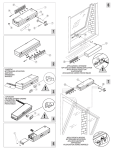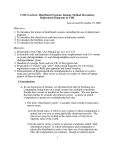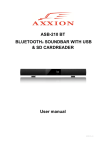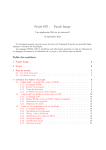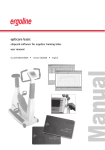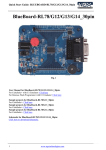Download CS122 Lecture: Architectural Design
Transcript
CS122 Lecture: Architectural Design; the MVC and Client/Server Architectural Patterns last revised March 17, 2015 Objectives: 1. To introduce architectural design 2. To introduce UML diagrams relevant to architectural design - component diagram, deployment diagram 3. To introduce the use of packages 4. To discuss several architectural patterns Layered, MVC, Client-Server, Pipe and Filter Materials: 1. 2. 3. 4. 5. 6. 7. 8. 9. Projectable of fig 9.7 in book Projectable of another component diagram example Deployment diagram projectables (UML User Manual pages 412, 415) Projectable of figure 9.5 in book Projectable of Java layered architecture Projectable of alternative client-server architectures Projectable of pipe-and-filter architecture Projectable of pipe-and-filter structure of a compiler Projectable of transaction-processing architecture I. Introduction A. There are many kinds of design that go into developing a software system. Examples? ASK 1. Architectural design 2. Class design 3. User interface design 4. Today we focus on architectural design. 1 B. The highest level of design is sometimes called architectural design. 1. We can speak of system architecture, which deals with the overall structure of the system in terms of its subsystems and major components. For example, consider the anti-lock brake system of a car. The purpose of such a system is to prevent hard braking from locking the wheels, which produces skidding. Such a system consists of speed sensors for each wheel, a hydraulic valve that can be used to reduce braking pressure when one or more wheels lock up, and a software controller that senses when one or more wheels is rotating considerably slower than the others, indicating that it is about to lock up. In such a situation, the ABS controller pulses the hydraulic valve to momentarily reduce braking pressure, thus allowing the wheel that is about to lock up to turn again. The major components of this system, then, are 4 wheel sensors, a hydraulic valve, a microprocessor and software that runs on the microprocessor. 2. If the system has many classes - as it often does - we may choose to describe the system by using packages of related classes rather than showing the individual classes. (The examples we will do in this lecture use this approach) Quick-Check Questions d, e C. In any sort of design, one key thing we need to do is to partition a larger problem into smaller pieces. (The divide and conquer principle). At the system architectural level, the pieces go by different names, depending on what is actually involved: 1. A component is a piece of an overall system that has a clear role, can be isolated, and can, in principle, be replaced with a different component that provides the same functionality. A component may be software, hardware, or both. 2 Examples: a) A hardware device like a computer’s monitor is a component. b) A web-browser is a component. c) In designing software, a key concept is the notion of a re-usable component, which is simply a component that can be “plugged in” to different problems Thus, in our ABS example, the components are the wheel speed sensors, the hydraulic valve, and the software running on the ABS Controller system. 2. A system is a collection of components that work together to do some job. Complex systems are often composed of definable subsystems, which have internal structure of their own. (Sometimes the term “system” is limited to just hardware and software, but other times the term is used more broadly to encompass people, processes, organizational structures etc.) In our ABS Controller example, it is likely the case that the wheel sensors and hydraulic valve are subsystems which might themselves be further analyzed. 3. When a system is geographically distributed, the subsystem at a particular location is often called a node. 3 II. UML Diagrams Relevant to Architectural Design UML has two kinds of diagrams that are useful at this level. A. A component diagram shows the major software components of a system and their relationships. QC Question f 1. Figure 9.7 in the book is an example of a component diagram. PROJECT 2. Another example: A typical structure for an e-commerce site is as follows: the web server houses a database of information about the company’s products. When a customer request is received, it generates a dynamic web page which it sends to the customer’s browser, based on a template stored on the server. (E.g. if the customer submits a search request, the server software searches the database and creates an appropriate search results page based on a template for such pages.) This can be depicted as follows (using UML 1 notation, which is the notation used in the book - UML 2 is different) PROJECT Dynamic Web Page Server Software Web Page Web PageWeb Template Page Template Template 4 Database B. A deployment diagram shows the major hardware components of a system and their relationships, and also indicates which software components are allocated to each hardware component. It is particularly useful for use with distributed systems, in which the hardware components are located at different places. QC Question g 1. The major components of a deployment diagram are nodes - symbols representing either a processor or some significant piece of hardware that the system utilizes. The standard symbol for a node is a cube: a) Nodes representing specialized pieces of hardware can be represented by specialized symbols, as we shall see shortly. b) Nodes are connected by associations, representing the flow of information back and forth between them. c) We may also explicitly show the network which allows the nodes to communicate, if they communicate via a general-purpose network rather than via dedicated hard-wired connections. d) Note that, in contrast to other diagrams we have drawn, in a Deployment diagram the symbols represent hardware - not software. (The software is deployed on one or more processors, depicted by node symbols.) 2. Deployment diagrams can be used to depict several different types of systems: 5 a) Embedded Systems (1) An embedded system is one in which a computer is embedded in some piece of physical equipment to control it (e.g. a home appliance, a car, or a chemical plant) (2) The following example appears in the UML User Manual, depicting an embedded system controlling an autonomous robot PROJECT: UML User Manual page 412 Note that there is only one processor - the remaining nodes are specialized hardware controlled by software in the processor. Note also the used of specialized symbols for these nodes - chosen ad-hoc to help the reader understand the diagram. (These are not standard UML symbols!) (3) We could depict our ATM example system using such a diagram to depict the various specialized pieces of hardware in relationship to the controlling processor that runs the software we have discussed in previous lectures. Note that, in this case, we are depicting hardware - not the software that controls the hardware. (E.g. in previous discussions, we have used a class CardReader to represent the software that controls the physical device that reads ATM cards. In this diagram, that class is part of the software that is deployed on the processor that controls the system, and the card reader symbol stands for the physical hardware device it controls.) ASK FOR A VOLUNTEER TO PRODUCE SUCH A DRAWING ON THE BOARD. b) Client/Server Systems - which we will discuss more fully shortly A quick Example: Our ATM system (viewed now as a node) connected to the bank’s computer. ASK FOR A VOLUNTEER TO PRODUCE SUCH A DRAWING ON THE BOARD. 6 c) Fully-Distributed Systems Example: PROJECT - UML User Manual page 415 Note how the Internet is depicted, potentially connecting any console to any regional server, while direct hard-wired connections between specific servers are shown as associations. 3. A Deployment diagram is not required for the VideoStore example system, as specified. a) The system we have been designing thus far has been designed, presumably (but perhaps unrealistically), to run on a single computer b) Suppose, however, that we were to design it as a distributed system perhaps with several clerk consoles (computers), and perhaps some kiosks that customers can use to make inquiries. What might such a system look like? ASK DEVELOP A DEPLOYMENT DIAGRAM AS A CLASS. Some options to consider (1) Server - perhaps a separate system (2) Manager console - perhaps a separate system, or server system could double in this capacity. c) Note: for purposes of the project, do not attempt a distributed implementation! 7 III.Architectural Patterns A. It turns out that there are a variety of architectural design patterns that are appropriate for different situations. B. The book talked about another such pattern, which can be used both for hardware/software systems and for understanding purely software systems. ASK Layered architecture QC Question h - then pick up QCs 1. In a system using a layered architecture, the system is organized into layers. a) A given layer may only directly depend on the services provided by the layer immediately below it. b) Each layer defines an interface representing services it makes available to the next layer up. 2. Example: The book discussed a four layer architectural pattern that is quite common PROJECT Figure 9.5 from book 3. Example: Java implementations typically use a layered architecture that looks like this: PROJECT 8 Java Bytecodes (.class files) Java API JVM Implementation and native classes Platform (Native Operating System and Physical CPU) a) A JVM implementation is specific to a particular platform. It depends on the facilities of the native operating system, and is capable of executing any standard java class file. b) The bytecodes produced by the javac compiler (and the API routines in the java. and javax. packages in the system library) depend only on the standard java class file format Thus, the same class files will run on any java implementation, regardless of the platform. 4. Layered architectures are not confined to software. Layering is also used in systems comprised of software and hardware - e.g. there is a model for understanding computer networks called the ISO/OSI model which has seven distinct layers - several of which involve both software and hardware. The lowest layer is the physical layer- the physical means by which bits are transmitted from one place to another. A physical link can be something like ethernet, or fiber optics, or wireless. Higher layers should be unaffected by what choice is made at this layer, though. One manifestation of this is that a computer that is connected to a network via a wired connection can be seamlessly shifted to a wireless connection. 9 C. The student registration system that has been the basis of a couple of labs you have done/you and the starter software I gave you for the Video Store project are based on another architectural patttern, called the Model View Controller architectural pattern that is used extensively is the Model-View-Controller (MVC) architecture. Many GUI applications follow this pattern - often at multiple levels Model updates notifies about changes Controller interacts with View informs of actions 1. It has some key benefits in terms of producing a cohesive system a) Classes in each part of the system perform different sorts of tasks. (1) Classes in the model serve to represent entities that the system manipulates. Each class has, as its single task, representing some one kind of entity. (2) Classes in the view allow users to interact various aspects of the system - e.g. a specific entity, or a specific body of information, displaying information and receiving user requests. (a) When something in the model changes, it notifies the view (b) When an actor requests an operation in the view, it notifies the controller 10 (3) Classes in the controller represent various tasks (use cases) that the system performs, by updating the view in response to user requests b) Each part of the system, then, focusses on one type of thing: (1) The model focusses on representing information. (2) The view focusses on displaying information. (3) The controller focusses on carrying out user commands on information. c) Note that this is not a layered architecture, because the View depends on both the Model and Controller layers. 2. Both the registration system you worked with in lab and the video store starter code I gave you actually have three packages called model, view, and controller. (However, the “notifies about changes” dependency is not realized, because it would require use of a design pattern you don’t know about yet. We will talk about something like this might be done when we discuss the Observer design pattern in the next series of lectures.) 3. Can you think of an example of a system (other than the video store, of course) that uses this architecture? ASK The AddressBook System a) What classes constitute the model? ASK AddressBook, Person, FileSystem b) What classes constitute the view? ASK AddressBookGUI, MultiInputPane 11 c) What classes constitute the controller? ASK AddressBookController (also AddressBookApplication) d) It is also possible to construct a simplified class diagram in which special symbols are used to denote entity classes (generally found in the model), boundary classes (often found in the view) and controller classes. PROJECT AddressBook “Further Analysis” page 4. This basic structure is also used internally in Swing e.g., though Swing is used for the view part of an MVC system, internally it makes use of distinct models. a) Note interfaces whose name ends with Model in the Swing documentation SHOW b) Go through description in the documentation for (1) ListModel (2) ComboBoxModel (3) ButtonModel c) For each interface, Swing supplies a default implementation that is used in most cases (though you can produce your own if necessary). SHOW Default implementations for the above in documentation D. Another pattern is the client-server architecture - a pattern that occurs over and over in Internet applications. 12 1. In the simplest case, a client-server system consists of a server system and (one or more) client subsystems. For example, a web browser relates as a client to a web server; the mail program running on a personal computer acts as client to a mail server, etc. 2. More complex systems can be understood in terms of a layered model: a user-interface layer, a business-logic layer, and a database layer. For example, many e-commerce systems are set up this way: the user interface layer is a web page (perhaps with embedded javascript) viewed by a web browser; the business-logic layer is the software that provides information in response to user requests and processes orders, and the database layer stores information about the products and records user orders. There are three different ways these might be distributed: PROJECT a) An approach often used by e-commerce systems (the so-called “thin client” approach) User-interface layer Client System(s) Business-logic layer Server System Database layer b) The so-called “thick client” approach, used when it is desirable to install the business logic software on the client system (This wouldn’t work for e-commerce, of course, but is sometimes used for specialized applications) 13 User-interface layer Client System(s) Business-logic layer Database layer Server System c) A three-layer approach that can also be used as an alternative to the thin client approach. (Note that the client would never see any difference between this approach and the thin-client approach; in fact, many e-commerce systems are in fact built this way) Client System(s) User-interface layer “Visible” Server System Business-logic layer Database Server System (Invisible to clients) Database layer 14 3. While the client-server architecture is most commonly seen in distributed systems, it can also be used for software systems running on a single computer - e.g. a program that uses a relational database is often structured as a client relating to a separate database server program running on the same computer. (In fact, a database server program running on a computer may simultaneously be serving several different clients on that same machine.) E. An alternative architecture for distributed systems is a Peer-to-Peer architecture in which there is no designated server as such. Instead, each participating system can function either as a client, or as a server to some other system. F. Another architectural pattern is the “Pipe and Filter” Pattern. In this approach, a system is organized as a collection of subsystems called filters. The overall input to the system flows into the first filter, which performs some transformation on it and sends the transformed data to the second filter, which performs a further transformation on it and sends it to the third filter ... PROJECT Raw Input Filter 1 Filter 2 Filter 3 ••• Filter n Final Output 1. One place where this architecture is often used is compilers. Thus, a simple compiler might be organized like this: PROJECT Source Program (stream of characters) Tokenizer Stream of Tokens Parser Parse Tree Code Generator (More sophisticated compilers include various code-improvement (so-called “optimization”) steps which may be inserted either between the parser and the code generator, or after the code generator - or often both) 15 Object Program 2. Another place where pipe and filter architecture is often used is in systems that process signals such as sounds (e.g. speech recognition systems.) In fact, the term “filter” really comes from the world of hardware signal-processing systems. 16

















